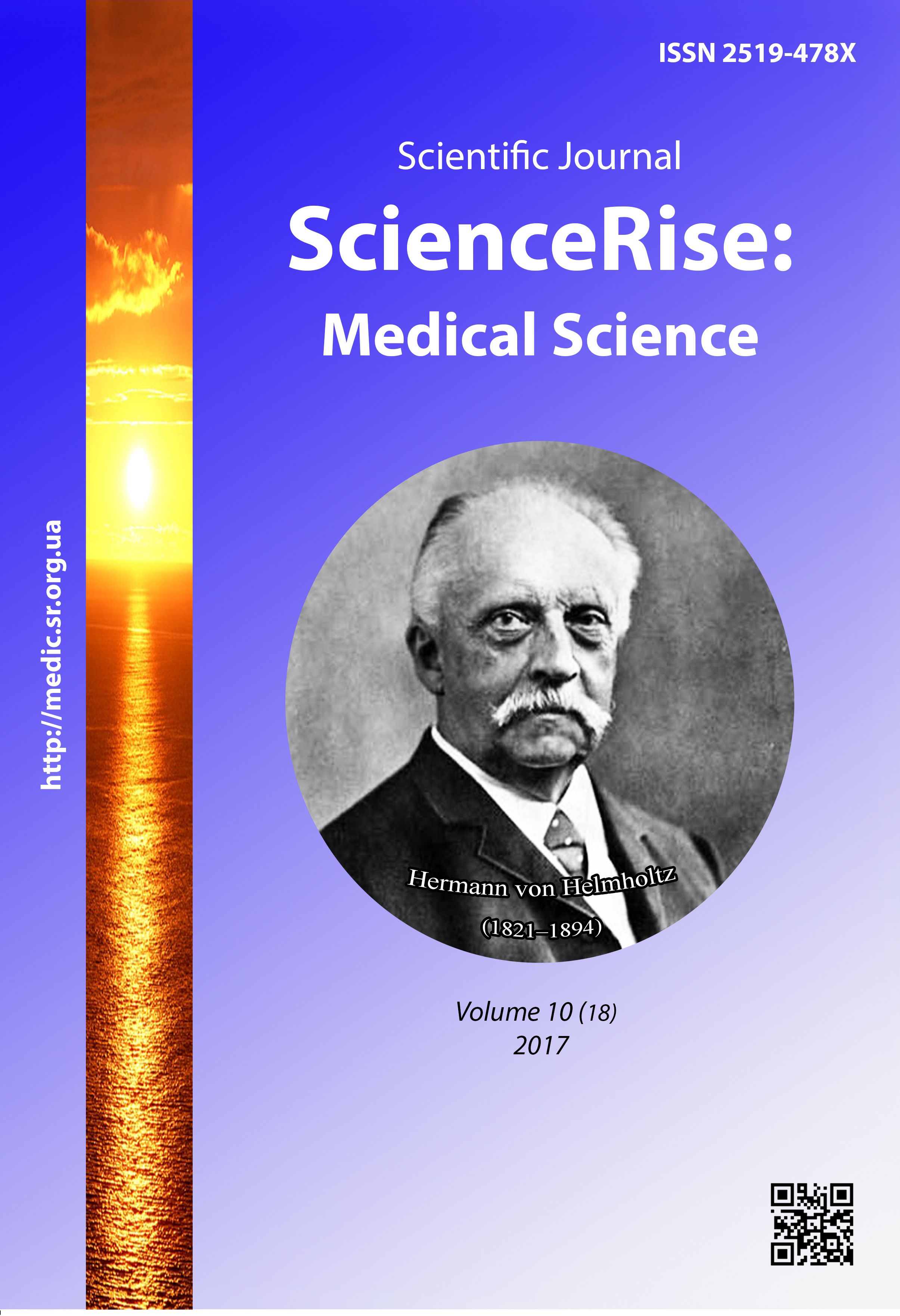Дослідження поширеності поліморфізму гену TLR 9 типу у хворих на інфекційний мононуклеоз, викликаний вірусом Епштейна-Барр
DOI:
https://doi.org/10.15587/2519-4798.2017.113311Ключові слова:
інфекційний мононуклеоз, вірус Епштейна-Барр, Толл-подібні рецептори, поліморфізм, розповсюдженняАнотація
Досліджено поширеність поліморфізму -1486Т/С гену TLR-9 у хворих на інфекційний мононуклеоз, викликаний вірусом Епштейна-Барр. Виявлено три основних генотипи – ТТ, ТС, СС. Встановлено домінування генотипів СС та ТТ, порівняно з контролем. Аналіз розподілу частот поліморфізму продемонстрував специфічність змін для генотипу СС та відсутність таких для генотипів ТТ та ТС
Посилання
- Drutskaya, M. S., Belousov, P. V., Nedospasov, S. A. (2011). Vrozhdennoe raspoznavanie virusov. Molekulyarnaya biologiya, 25 (3), 7–19.
- Sha, Q., Truong-Tran, A. Q., Plitt, J. R., Beck, L. A., Schleimer, R. P. (2004). Activation of Airway Epithelial Cells by Toll-Like Receptor Agonists. American Journal of Respiratory Cell and Molecular Biology, 31 (3), 358–364. doi: 10.1165/rcmb.2003-0388oc
- Vaidya, S. A., Cheng, G. (2003). Toll-like receptors and innate antiviral responses. Current Opinion in Immunology, 15 (4), 402–407. doi: 10.1016/s0952-7915(03)00070-0
- Barton, G. M. (2007). Viral recognition by Toll-like receptors. Seminars in Immunology, 19 (1), 33–40. doi: 10.1016/j.smim.2007.01.003
- Kawai, T., Akira, S. (2010). The role of pattern-recognition receptors in innate immunity: update on Toll-like receptors. Nature Immunology, 11 (5), 373–384. doi: 10.1038/ni.1863
- Sandor, F., Buc, M. (2005). Toll-like receptors. I. Structure, function and their ligands. Folia Biol (Praha), 51 (5), 148–157.
- Torres, S., Hernández, J. C., Giraldo, D., Arboleda, M., Rojas, M., Smit, J. M., Urcuqui-Inchima, S. (2013). Differential Expression of Toll-like Receptors in Dendritic Cells of Patients with Dengue during Early and Late Acute Phases of the Disease. PLoS Neglected Tropical Diseases, 7 (2), e2060. doi: 10.1371/journal.pntd.0002060
- Gibson, J., Gow, N., Wong, S. Y. C. (2010). Expression and Functions of Innate Pattern Recognition Receptors in T and B Cells. Immunology‚ Endocrine & Metabolic Agents in Medicinal Chemistry, 10 (1), 11–20. doi: 10.2174/187152210791171304
- Iskra, S., Kalla, M., Delecluse, H.-J., Hammerschmidt, W., Moosmann, A. (2010). Toll-Like Receptor Agonists Synergistically Increase Proliferation and Activation of B Cells by Epstein-Barr Virus. Journal of Virology, 84 (7), 3612–3623. doi: 10.1128/jvi.01400-09
- Bochud, P.-Y., Hersberger, M., Taffé, P., Bochud, M., Stein, C. M., Rodrigues, S. D. et. al. (2007). Polymorphisms in Toll-like receptor 9 influence the clinical course of HIV-1 infection. AIDS, 21 (4), 441–446. doi: 10.1097/qad.0b013e328012b8ac
- Vozianova, Zh. I., Hlei, A. I. (2004). Infektsiynyi mononukleoz yak polietyolohichne zakhvoriuvannia. Suchasni infektsyi, 2, 37–41.
- Thuong, N. T. T., Hawn, T. R., Thwaites, G. E., Chau, T. T. H., Lan, N. T. N., Quy, H. T. et. al. (2007). A polymorphism in human TLR2 is associated with increased susceptibility to tuberculous meningitis. Genes and Immunity, 8 (5), 422–428. doi: 10.1038/sj.gene.6364405
- Carvalho, A., Cunha, C., Almeida, A. J., Osório, N. S., Saraiva, M., Teixeira-Coelho, M. et. al. (2011). The rs5743836 polymorphism in TLR9 confers a population-based increased risk of non-Hodgkin lymphoma. Genes and Immunity, 13 (2), 197–201. doi: 10.1038/gene.2011.59
- Woehrle, T., Du, W., Goetz, A., Hsu, H.-Y., Joos, T. O., Weiss, M. et. al. (2008). Pathogen specific cytokine release reveals an effect of TLR2 Arg753Gln during Candida sepsis in humans. Cytokine, 41 (3), 322–329. doi: 10.1016/j.cyto.2007.12.006
- Kijpittayarit, S., Eid, A. J., Brown, R. A., Paya, C. V., Razonable, R. R. (2007). Relationship between Toll-Like Receptor 2 Polymorphism and Cytomegalovirus Disease after Liver Transplantation. Clinical Infectious Diseases, 44 (10), 1315–1320. doi: 10.1086/514339
- Akin, E., McHugh, G. L., Flavell, R. A., Fikrig, E., Steere, A. C. (1999). The Immunoglobulin (IgG) Antibody Response to OspA and OspB Correlates with Severe and Prolonged Lyme Arthritis and the IgG Response to P35 Correlates with Mild and Brief Arthritis. Infection and Immunity, 67 (1), 173–181.
- Bernardino, A. L. F., Myers, T. A., Alvarez, X., Hasegawa, A., Philipp, M. T. (2008). Toll-Like Receptors: Insights into Their Possible Role in the Pathogenesis of Lyme Neuroborreliosis. Infection and Immunity, 76 (10), 4385–4395. doi: 10.1128/iai.00394-08
- Salazar, J. C., Pope, C. D., Sellati, T. J., Feder, H. M., Kiely, T. G. et. al. (2003). Coevolution of Markers of Innate and Adaptive Immunity in Skin and Peripheral Blood of Patients with Erythema Migrans. The Journal of Immunology, 171 (5), 2660–2670. doi: 10.4049/jimmunol.171.5.2660
- Gaudreault, E., Fiola, S., Olivier, M., Gosselin, J. (2007). Epstein-Barr Virus Induces MCP-1 Secretion by Human Monocytes via TLR2. Journal of Virology, 81 (15), 8016–8024. doi: 10.1128/jvi.00403-07
- Fathallah, I., Parroche, P., Gruffat, H., Zannetti, C., Johansson, H., Yue, J. et. al. (2010). EBV Latent Membrane Protein 1 Is a Negative Regulator of TLR9. The Journal of Immunology, 185 (11), 6439–6447. doi: 10.4049/jimmunol.0903459
- Fiola, S., Gosselin, D., Takada, K., Gosselin, J. (2010). TLR9 Contributes to the Recognition of EBV by Primary Monocytes and Plasmacytoid Dendritic Cells. The Journal of Immunology, 185 (6), 3620–3631. doi: 10.4049/jimmunol.0903736
- Paradowska, E., Jabłońska, A., Studzińska, M., Skowrońska, K., Suski, P., Wiśniewska-Ligier, M. et. al. (2016). TLR9 -1486T/C and 2848C/T SNPs Are Associated with Human Cytomegalovirus Infection in Infants. PLOS ONE, 11 (4), e0154100. doi: 10.1371/journal.pone.0154100
##submission.downloads##
Опубліковано
Як цитувати
Номер
Розділ
Ліцензія
Авторське право (c) 2017 Татьяна Ивановна Лядова

Ця робота ліцензується відповідно до Creative Commons Attribution 4.0 International License.
Наше видання використовує положення про авторські права Creative Commons CC BY для журналів відкритого доступу.
Автори, які публікуються у цьому журналі, погоджуються з наступними умовами:
1. Автори залишають за собою право на авторство своєї роботи та передають журналу право першої публікації цієї роботи на умовах ліцензії Creative Commons CC BY, котра дозволяє іншим особам вільно розповсюджувати опубліковану роботу з обов'язковим посиланням на авторів оригінальної роботи та першу публікацію роботи у цьому журналі.
2. Автори мають право укладати самостійні додаткові угоди щодо неексклюзивного розповсюдження роботи у тому вигляді, в якому вона була опублікована цим журналом (наприклад, розміщувати роботу в електронному сховищі установи або публікувати у складі монографії), за умови збереження посилання на першу публікацію роботи у цьому журналі.










